Spatial Pattern of Farmland Abandonment in Japan: Identification and Determinants
Abstract
1. Introduction
2. Materials and Methods
2.1. Study Area
2.2. Data
2.3. Description and Selection of Explanatory Variables
2.4. Methods
2.4.1. Ordinary Least Squares (OLS)
2.4.2. Geographically Weighted Regression (GWR)
2.4.3. Local Moran’s I
3. Results
3.1. Spatial Patterns of Farmland Abandonment in Japan
3.1.1. General Characteristics of Farmland Abandonment
3.1.2. Spatial Patterns
3.1.3. Spatial Autocorrelations
3.2. Ordinary Least Squares
3.3. Geographically Weighted Regression
4. Discussion and Conclusions
4.1. Discussion
4.2. Conclusions
Author Contributions
Funding
Acknowledgments
Conflicts of Interest
Appendix A
| X1 | X2 | X3 | X4 | X5 | X6 | X7 | X8 | X9 | X10 | X11 | X12 | |
| X1 | 1 | |||||||||||
| X2 | −0.162 ** | 1 | ||||||||||
| X3 | −0.091 ** | 0.046 ** | 1 | |||||||||
| X4 | 0.254 ** | 0.036 ** | 0.024 * | 1 | ||||||||
| X5 | −0.131 ** | 0.015 | 0.016 | −0.014 | 1 | |||||||
| X6 | −0.134 ** | −0.045 ** | −0.023 * | −0.343 ** | −0.010 | 1 | ||||||
| X7 | −0.224 ** | −0.024* | 0.003 | −0.293 ** | 0.096 ** | 0.331 ** | 1 | |||||
| X8 | −0.234 ** | 0.023* | 0.002 | −0.128 ** | −0.027 ** | 0.318 ** | 0.499 ** | 1 | ||||
| X9 | 0.236 ** | −0.071 ** | −0.035 ** | 0.085 ** | −0.051 ** | 0.024 * | 0.013 | 0.014 | 1 | |||
| X10 | −0.088 ** | −0.052 ** | 0.003 | −0.206 ** | 0.413 ** | 0.060 ** | 0.089 ** | −0.179 ** | −0.003 | 1 | ||
| X11 | −0.192 ** | −0.025 * | −0.013 | −0.123 ** | 0.081 ** | −0.033 ** | 0.163 ** | 0.144 ** | −0.040 ** | 0.070 ** | 1 | |
| X12 | −0.101 ** | 0.014 | 0.037 ** | −0.173 ** | 0.191 ** | −0.018 | −0.179 ** | −0.494 ** | −0.222 ** | 0.389 ** | −0.118 ** | 1 |
References
- MacDonald, D.; Crabtree, J.R.; Wiesinger, G.; Dax, T.; Stamou, N.; Fleury, P.; Lazpita, J.G.; Gibon, A. Agricultural abandonment in mountain areas of Europe: Environmental consequences and policy response. J. Environ. Manag. 2000, 59, 47–69. [Google Scholar] [CrossRef]
- Lasanta, T.; Nadal-Romero, E.; Arnáez, J. Managing abandoned farmland to control the impact of re-vegetation on the environment. The state of the art in Europe. Environ. Sci. Policy 2015, 52, 99–109. [Google Scholar] [CrossRef]
- Li, S.; Li, X. Global understanding of farmland abandonment: A review and prospects. J. Geogr. Sci. 2017, 27, 1123–1150. [Google Scholar] [CrossRef]
- Benayas, J.R.; Martins, A.; Nicolau, J.M.; Schulz, J.J. Abandonment of agricultural land: An overview of drivers and consequences. CAB Rev. Perspect. Agric. Vet. Sci. Nutr. Nat. Resour. 2007, 2, 1–14. [Google Scholar] [CrossRef]
- Corbelle-Rico, E.; Crecente-Maseda, R. Evaluating IRENA indicator ‘Risk of Farmland Abandonment’ on a low spatial scale level: The case of Galicia (Spain). Land Use Policy 2014, 38, 9–15. [Google Scholar] [CrossRef]
- Yan, J.; Yang, Z.; Li, Z.; Li, X.; Xin, L.; Sun, L. Drivers of cropland abandonment in mountainous areas: A household decision model on farming scale in Southwest China. Land Use Policy 2016, 57, 459–469. [Google Scholar] [CrossRef]
- Verburg, P.H.; Overmars, K.P. Combining top-down and bottom-up dynamics in land use modeling: Exploring the future of abandoned farmlands in Europe with the Dyna-CLUE model. Landsc. Ecol. 2009, 24, 1167–1181. [Google Scholar] [CrossRef]
- Prishchepov, A.V.; Radeloff, V.C.; Baumann, M.; Kuemmerle, T.; Müller, D. Effects of institutional changes on land use: Agricultural land abandonment during the transition from state-command to market-driven economies in post-Soviet Eastern Europe. Environ. Res. Lett. 2012, 7, 024021. [Google Scholar] [CrossRef]
- Zakkak, S.; Radovic, A.; Nikolov, S.C.; Shumka, S.; Kakalis, L.; Kati, V. Assessing the effect of agricultural land abandonment on bird communities in southern-eastern Europe. J. Environ. Manag. 2015, 164, 171–179. [Google Scholar] [CrossRef] [PubMed]
- Kolecka, N.; Kozak, J.; Kaim, D.; Dobosz, M.; Ostafin, K.; Ostapowicz, K.; Wężyk, P.; Price, B. Understanding farmland abandonment in the Polish Carpathians. Appl. Geogr. 2017, 88, 62–72. [Google Scholar] [CrossRef]
- Prishchepov, A.A.; Müller, D.; Dubinin, M.; Baumann, M.; Radeloff, V.C. Determinants of agricultural land abandonment in post-Soviet European Russia. Land Use Policy 2013, 30, 873–884. [Google Scholar] [CrossRef]
- Ramankutty, N.; Heller, E.; Rhemtulla, J. Prevailing myths about agricultural abandonment and forest regrowth in the United States. Ann. Assoc. Am. Geogr. 2010, 100, 502–512. [Google Scholar] [CrossRef]
- Löw, F.; Fliemann, E.; Abdullaev, I.; Conrad, C.; Lamers, J.P.A. Mapping abandoned agricultural land in Kyzyl-Orda, Kazakhstan using satellite remote sensing. Appl. Geogr. 2015, 62, 377–390. [Google Scholar] [CrossRef]
- Yamaguchi, T.; Ngodup, S.; Nose, M.; Takeda, S. Community-scale analysis of the farmland abandonment occurrence process in the mountain region of Ladakh, India. J. Land Use Sci. 2016, 11, 401–416. [Google Scholar] [CrossRef]
- Díaz, G.I.; Nahuelhual, L.; Echeverría, C.; Marín, S. Drivers of land abandonment in Southern Chile and implications for landscape planning. Landsc. Urban Plan. 2011, 99, 207–217. [Google Scholar] [CrossRef]
- Xie, H.L.; Wang, P.; Yao, G.R. Exploring the dynamic mechanisms of farmland abandonment based on a spatially explicit economic model for environmental sustainability: A case study in Jiangxi Province, China. Sustainability 2014, 6, 1260–1282. [Google Scholar] [CrossRef]
- Kawashima, S. Spatial Regression Analysis on Abandoned Farm Land using Agricultural Census and its Map Data. Tohoku J. Rural Econ. 2010, 28, 23–29. (In Japanese) [Google Scholar] [CrossRef][Green Version]
- Corbelle-Rico, E.; Crecente-Maseda, R.; Santé-Riveira, I. Multi-scale assessment and spatial modelling of agricultural land abandonment in a European peripheral region: Galicia (Spain), 1956–2004. Land Use Policy 2012, 29, 493–501. [Google Scholar] [CrossRef]
- Scherr, S.J.; McNeely, J.A. Biodiversity conservation and agricultural sustainability: Towards a new paradigm of “ecoagriculture” landscapes. Phil. Trans. R. Soc. B 2007, 363, 477–494. [Google Scholar] [CrossRef] [PubMed]
- Queiroz, C.; Beilin, R.; Folke, C.; Lindborg, R. Farmland abandonment: Threat or opportunity for biodiversity conservation? A global review. Front. Ecol. Environ. 2014, 12, 288–296. [Google Scholar] [CrossRef]
- Yamashita, R.; Hoshino, S. Development of an agent-based model for estimation of agricultural land preservation in rural Japan. Agric. Syst. 2017, 164, 264–276. [Google Scholar] [CrossRef]
- Osawa, T.; Kohyama, K.; Mitsuhashi, H. Multiple factors drive regional agricultural abandonment. Sci. Total Environ. 2016, 542, 478–483. [Google Scholar] [CrossRef] [PubMed]
- Ito, J.; Nishikori, M.; Toyoshi, M.; Feuer, H.N. The contribution of land exchange institutions and markets in countering farmland abandonment in Japan. Land Use Policy 2016, 57, 582–593. [Google Scholar] [CrossRef]
- Pazúr, R.; Lieskovský, J.; Feranec, J.; Oťaheľ, J. Spatial determinants of abandonment of large-scale arable lands and managed grasslands in Slovakia during the periods of post-socialist transition and European Union accession. Appl. Geogr. 2014, 54, 118–128. [Google Scholar] [CrossRef]
- Rudel, T.K.; Coomes, O.T.; Moran, E.; Achard, F.; Angelsen, A.; Xu, J.; Lambin, E. Forest transitions: Towards a global understanding of land use change. Glob. Environ. Chang. 2005, 15, 23–31. [Google Scholar] [CrossRef]
- Larsson, S.; Nilsson, C. A remote sensing methodology to assess the costs of preparing abandoned farmland for energy crop cultivation in northern Sweden. Biomass Bioenergy 2005, 28, 1–6. [Google Scholar] [CrossRef]
- Estel, S.; Kuemmerle, T.; Alcántara, C.; Levers, C.; Prishchepov, A.; Hostert, P. Mapping farmland abandonment and recultivation across Europe using MODIS NDVI time series. Remote Sens. Environ. 2015, 163, 312–325. [Google Scholar] [CrossRef]
- Lieskovský, J.; Bezák, P.; Špulerová, J.; Lieskovský, T.; Koleda, P.; Dobrovodská, M.; Bürgi, M.; Gimmi, U. The abandonment of traditional agricultural landscape in Slovakia—Analysis of extent and driving forces. J. Rural Stud. 2015, 37, 75–84. [Google Scholar] [CrossRef]
- Löw, F.; Prishchepov, A.V.; Waldner, F.; Dubovyk, O.; Akramkhanov, A.; Biradar, C.; Lamers, J. Mapping Cropland abandonment in the Aral Sea Basin with MODIS time series. Remote Sens. 2018, 10, 159. [Google Scholar] [CrossRef]
- Mottet, A.; Ladet, S.; Coqué, N.; Gibon, A. Agricultural land-use change and its drivers in mountain landscapes: A case study in the Pyrenees. Agric. Ecosyst. Environ. 2006, 114, 296–310. [Google Scholar] [CrossRef]
- Baumann, M.; Kuemmerle, T.; Elbakidze, M.; Ozdogan, M.; Radeloff, V.C.; Keuler, N.S.; Prishchepov, A.V.; Kruhlov, I.; Hostert, P. Patterns and drivers of post-socialist farmland abandonment in Western Ukraine. Land Use Policy 2011, 28, 552–562. [Google Scholar] [CrossRef]
- Müller, D.; Leitão, P.J.; Sikor, T. Comparing the determinants of cropland abandonment in Albania and Romania using boosted regression trees. Agric. Syst. 2013, 117, 66–77. [Google Scholar] [CrossRef]
- Liu, Y.; Luo, T.; Liu, Z.; Kong, X.; Li, J.; Tan, R. A comparative analysis of urban and rural construction land use change and driving forces: Implications for urban–rural coordination development in Wuhan, Central China. Habitat Int. 2015, 47, 113–125. [Google Scholar] [CrossRef]
- Terres, J.M.; Scacchiafichi, L.N.; Wania, A.; Ambar, M.; Anguiano, E.; Buckwell, A.; Coppola, A.; Gocht, A.; Källström, H.N.; Pointereau, P.; et al. Farmland abandonment in Europe: Identification of drivers and indicators, and development of a composite indicator of risk. Land Use Policy 2015, 49, 20–34. [Google Scholar] [CrossRef]
- Zhang, Y.; Li, X.; Song, W. Determinants of cropland abandonment at the parcel, household and village levels in mountain areas of China: A multi-level analysis. Land Use Policy 2014, 41, 186–192. [Google Scholar] [CrossRef]
- Sang, N.; Dramstad, W.E.; Bryn, A. Regionality in Norwegian farmland abandonment: Inferences from production data. Appl. Geogr. 2014, 55, 238–247. [Google Scholar] [CrossRef]
- Uematsu, Y.; Koga, T.; Mitsuhashi, H.; Ushimaru, A. Abandonment and intensified use of agricultural land decrease habitats of rare herbs in semi-natural grasslands. Agric. Ecosyst. Environ. 2010, 135, 304–309. [Google Scholar] [CrossRef]
- Heller, P.S. The challenge of an aged and shrinking population: Lessons to be drawn from Japan’s experience. J. Econ. Ageing 2016, 8, 85–93. [Google Scholar] [CrossRef]
- Morimoto, T. Idle and abandoned farmland in Kashiwai-cho 4-chome, Ichikawa City, Chiba prefecture. Geogr. Rev. Jpn. 1993, 66, 81–87. (In Japanese) [Google Scholar] [CrossRef]
- Yokomichi, K. The Development of Municipal Mergers in Japan; Up-to-date Doc. Local Auton. Japan; Council of Local Authorities for International Relations (CLAIR): Tokyo, Japan, 2007; Volume 4.
- Ministry of Internal Affairs and Communications Japan. Statistical Handbook of Japan; MAFF: Tokyo, Japan, 2015.
- Gellrich, M.; Baur, P.; Koch, B.; Zimmermann, N.E. Agricultural land abandonment and natural forest re-growth in the Swiss mountains: A spatially explicit economic analysis. Agric. Ecosyst. Environ. 2007, 118, 93–108. [Google Scholar] [CrossRef]
- Fukamachi, K. Sustainability of terraced paddy fields in traditional satoyama landscapes of Japan. J. Environ. Manag. 2017, 202, 543–549. [Google Scholar] [CrossRef] [PubMed]
- Pirdavani, A.; Bellemans, T.; Brijs, T.; Kochan, B.; Wets, G. Assessing the road safety impacts of a teleworking policy by means of geographically weighted regression method. J. Transp. Geogr. 2014, 39, 96–110. [Google Scholar] [CrossRef]
- Kemp, F. Applied multiple regression/correlation analysis for the behavioral sciences. J. R. Stat. Soc. Ser. D 2003, 52, 691. [Google Scholar] [CrossRef]
- Tu, J. Spatially varying relationships between land use and water quality across an urbanization gradient explored by geographically weighted regression. Appl. Geogr. 2011, 31, 376–392. [Google Scholar] [CrossRef]
- Anselin, L. Local Indicators of Spatial Association—LISA. Geogr. Anal. 1995, 27, 93–115. [Google Scholar] [CrossRef]
- Ord, J.K.; Getis, A. Local Spatial Autocorrelation Statistics: Distributional Issues and an Application. Geogr. Anal. 1995, 27, 286–306. [Google Scholar] [CrossRef]
- Clement, F.; Orange, D.; Williams, M.; Mulley, C.; Epprecht, M. Drivers of afforestation in Northern Vietnam: Assessing local variations using geographically weighted regression. Appl. Geogr. 2009, 29, 561–576. [Google Scholar] [CrossRef]
- Brunsdon, C.; Fotheringham, A.S.; Charlton, M. Some notes on parametric significance tests for geographically weighted regression. J. Reg. Sci. 1999, 39, 497–524. [Google Scholar] [CrossRef]
- Oliveira, S.; Pereira, J.M.C.; San-Miguel-Ayanz, J.; Lourenço, L. Exploring the spatial patterns of fire density in Southern Europe using Geographically Weighted Regression. Appl. Geogr. 2014, 51, 143–157. [Google Scholar] [CrossRef]
- Jaimes, N.B.P.; Sendra, J.B.; Delgado, M.G.; Plata, R.F. Exploring the driving forces behind deforestation in the state of Mexico (Mexico) using geographically weighted regression. Appl. Geogr. 2010, 30, 576–591. [Google Scholar] [CrossRef]
- Chiou, Y.-C.; Jou, R.-C.; Yang, C.-H. Factors affecting public transportation usage rate: Geographically weighted regression. Transp. Res. Part A Policy Pract. 2015, 78, 161–177. [Google Scholar] [CrossRef]
- Deininger, K.; Savastano, S.; Carletto, C. Land Fragmentation, Cropland Abandonment, and Land Market Operation in Albania. World Dev. 2012, 40, 2108–2122. [Google Scholar] [CrossRef]
- Gen, S.J. Prevention Mechanism of Farmland Abandonment in a Mountain Village in Nishi-Aizu Town. Q. J. Geogr. 2015, 66, 284–297. (In Japanese) [Google Scholar]
- Kanzaka, S. Discovering Japan: A New Regional Geography; Teikoku-Shoin: Tokyo, Japan, 2009. [Google Scholar]
- Gibon, A.; Sheeren, D.; Monteil, C.; Ladet, S.; Balent, G. Modelling and simulating change in reforesting mountain landscapes using a social-ecological framework. Landsc. Ecol. 2010, 25, 267–285. [Google Scholar] [CrossRef]
- Matsuno, Y.; Nakamura, K.; Masumoto, T.; Matsui, H.; Kato, T.; Sato, Y. Prospects for multifunctionality of paddy rice cultivation in Japan and other countries in monsoon Asia. Paddy Water Environ. 2006, 4, 189–197. [Google Scholar] [CrossRef]
- Takahashi, D. The Agricultural Adjustment Problem of Japanese Agriculture: Technological Progress, Price Policies and Farmland Policies. J. Rural Econ. Back Issue 2015, 87, 9–22. (In Japanese) [Google Scholar]
- George-Mulgan, A. Japan’s Interventionist State: The Role of the MAFF; Taylor & Francis: Didcot, UK, 2004. [Google Scholar]
- Yoshizawa, S. Japanese Less Favored Areas & Regional Revitalization; Yoshio Tsurumi: Tokyo, Japan, 2003. [Google Scholar]
- Renwick, A.; Jansson, T.; Verburg, P.H.; Revoredo-Giha, C.; Britz, W.; Gocht, A.; McCracken, D. Policy reform and agricultural land abandonment in the EU. Land Use Policy 2013, 30, 446–457. [Google Scholar] [CrossRef]
- Grădinaru, S.R.; Iojă, C.I.; Onose, D.A.; Gavrilidis, A.A.; Pătru-Stupariu, I.; Kienast, F.; Hersperger, A.M. Land abandonment as a precursor of built-up development at the sprawling periphery of former socialist cities. Ecol. Indic. 2015, 57, 305–313. [Google Scholar] [CrossRef]
- Jentzsch, H. Abandoned land, corporate farming, and farmland banks: A local perspective on the process of deregulating and redistributing farmland in Japan. Contemp. Jpn. 2017, 29, 31–46. [Google Scholar] [CrossRef]
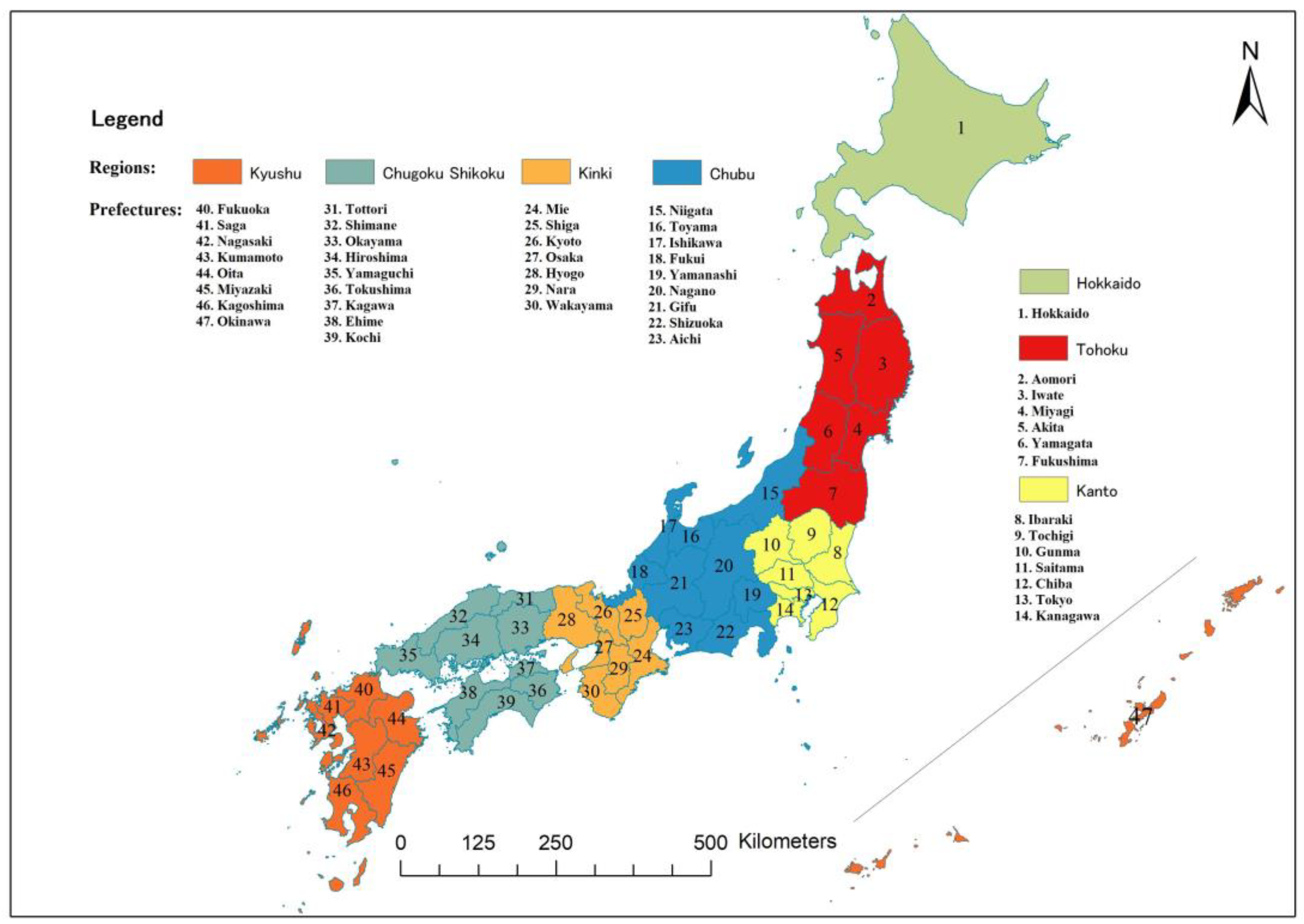

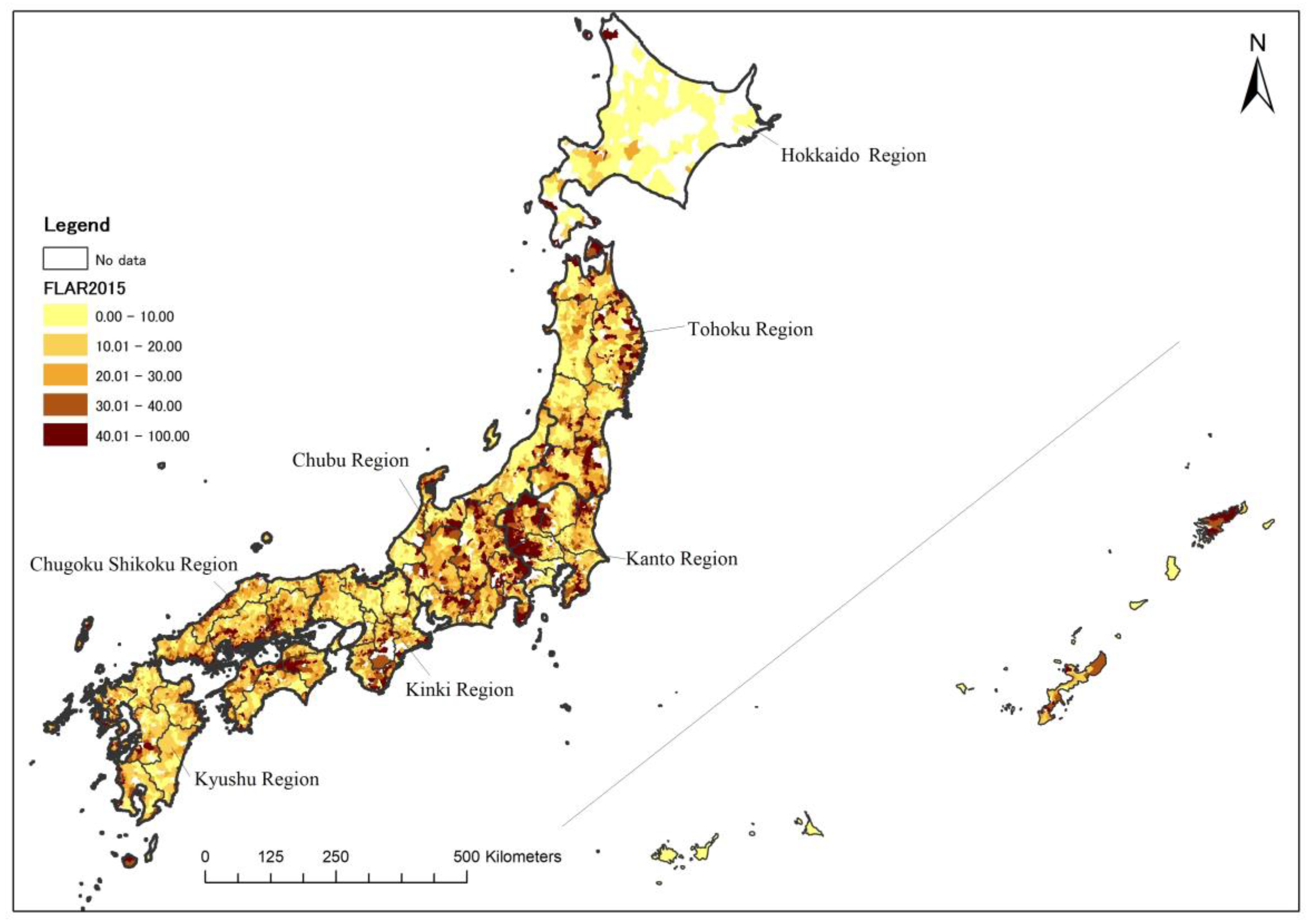

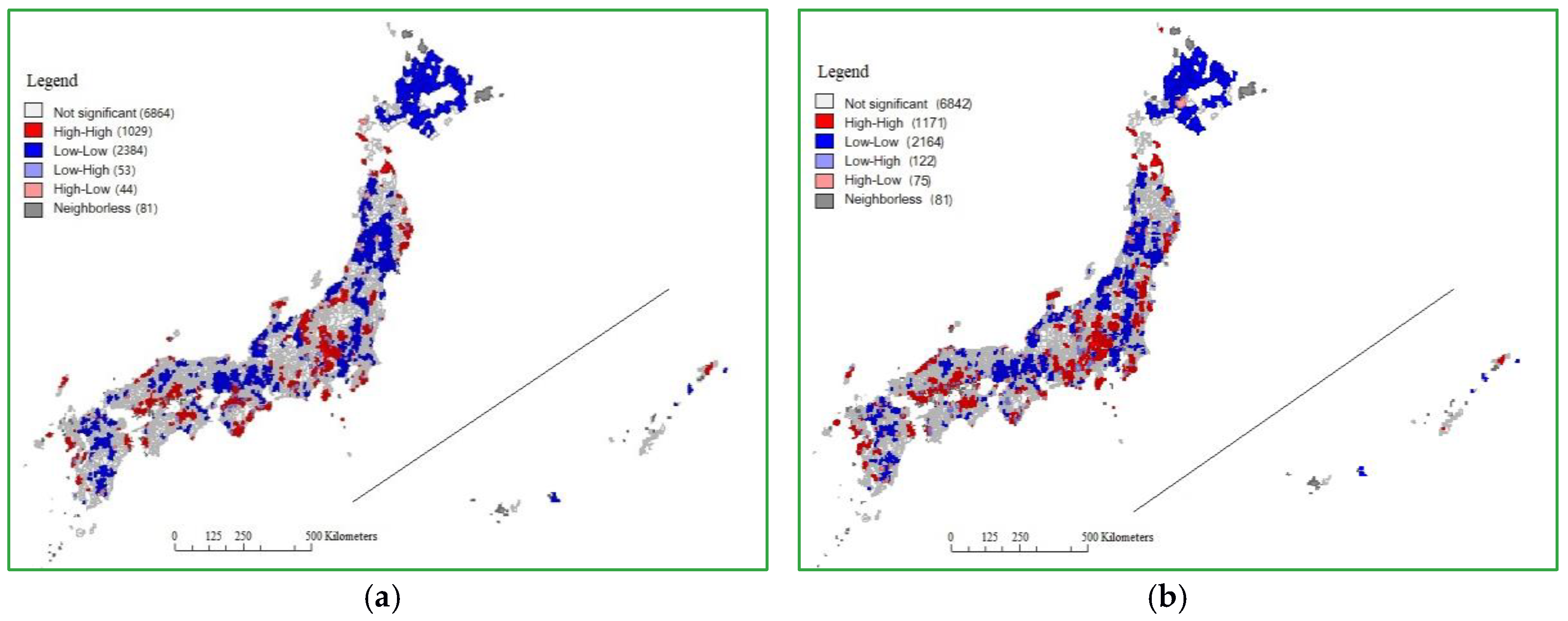



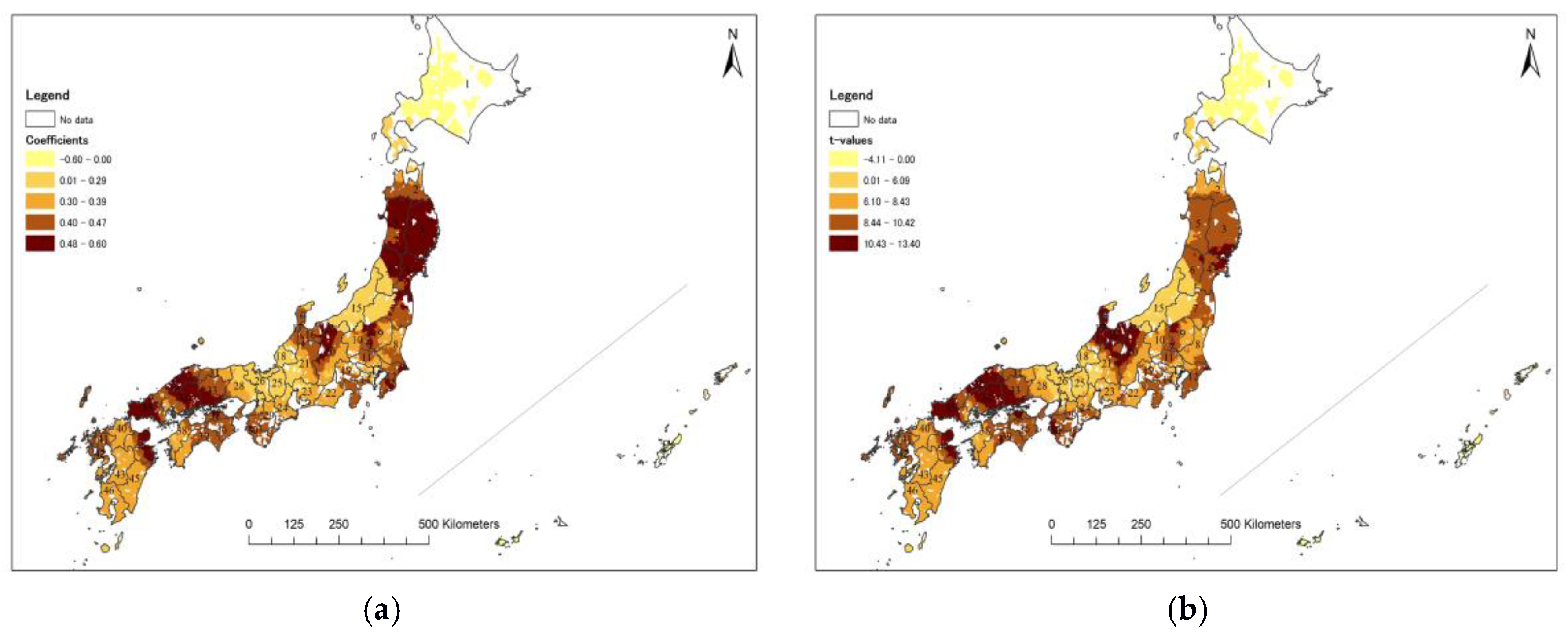
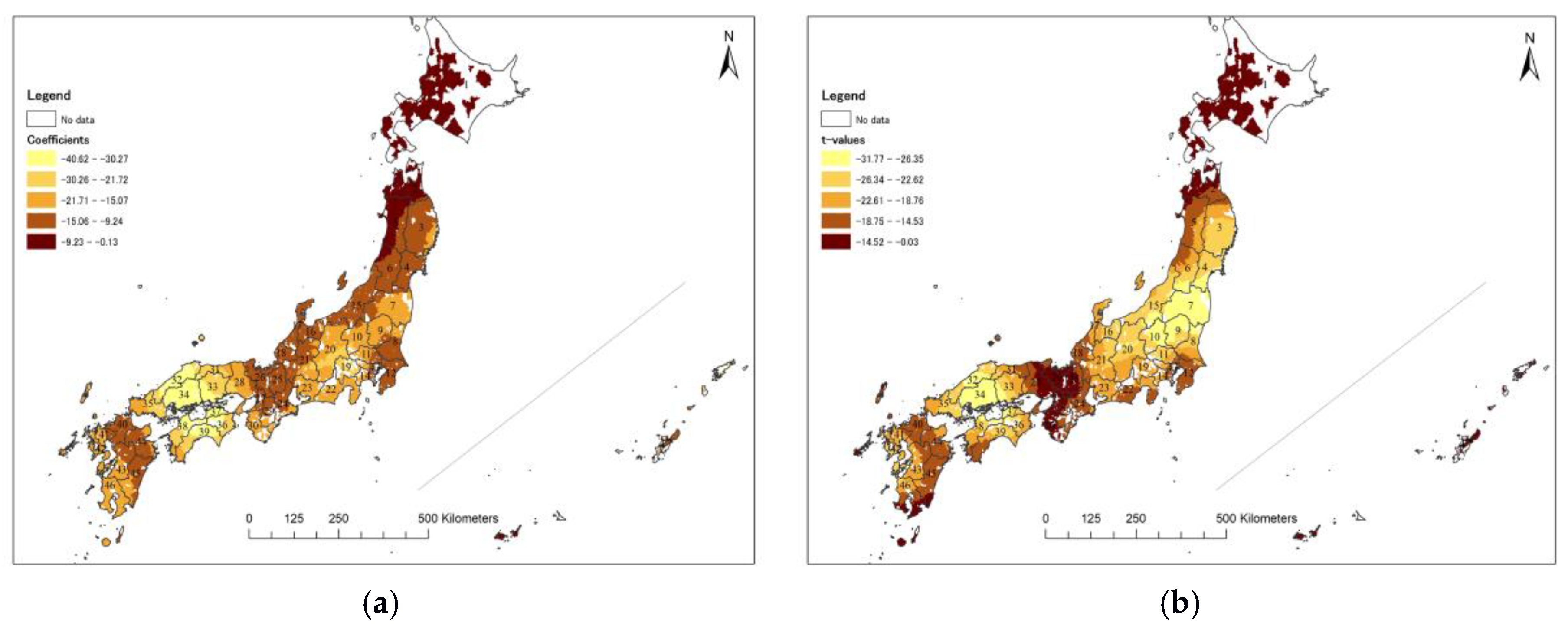

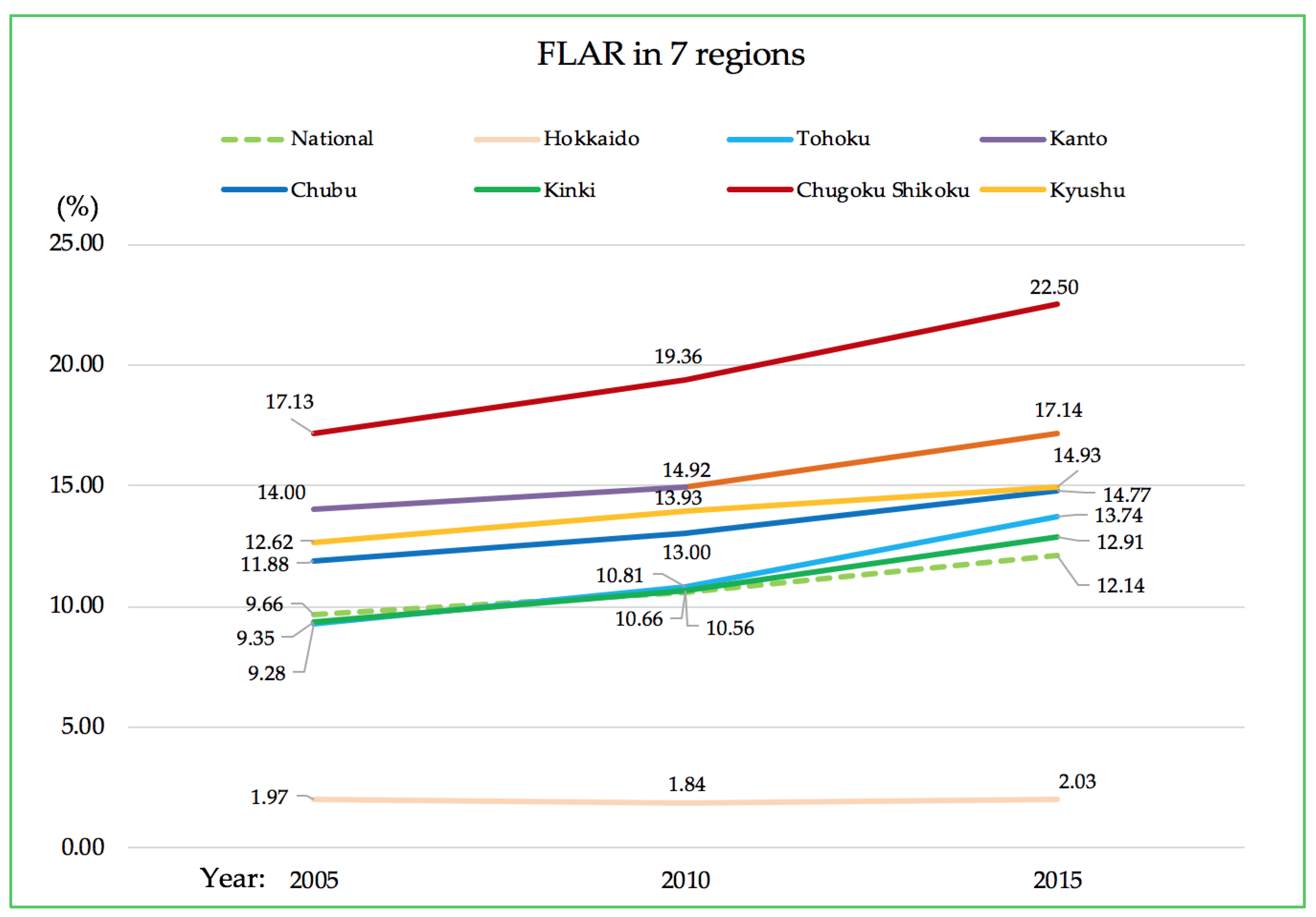
| Type of Variable | Description | Min | Max | Mean | SD |
|---|---|---|---|---|---|
| Dependent variable (Former municipality level, N = 9368) | |||||
| Y Farmland abandonment rate | Abandoned land area/(abandoned land area + total arable land area) (%) | 0 | 100 | 21.31 | 17.83 |
| Independent variables (Former municipality level, N = 9396) | |||||
| Geographical factors: | |||||
| X1 Mean slope (degree) | To define the steepness | 0 | 38.84 | 13.20 | 9.85 |
| X2 Expressway density (km/km2) | To describe access by the expressway | 0 | 2.12 | 0.047 | 0.11 |
| X3 Railroad density (km/km2) | To describe access by railroad | 0 | 11.85 | 0.050 | 0.20 |
| Type of Variable | Description | Min | Max | Mean | SD |
|---|---|---|---|---|---|
| Independent variables (Former municipality level, N = 9368); Socio-economic factors: Farm household related: | |||||
| X4 Arable land ratio of self-sufficient farm households (TH) | Self-sufficient household arable land area/total arable land area (%) | 0 | 100 | 15.30 | 17.57 |
| X5 Arable land ratio of land tenure non-farm households (TH) | Non-farm household arable land area/total arable land area (%) | 0 | 100 | 25.12 | 73.04 |
| X6 Arable land area per farm household (TH) | Total arable land area/total farm households (ha) | 0.08 | 107.78 | 1.27 | 3.49 |
| X7 Ratio of the first type of part-time farm household (BH) | The first type of part-time farm household/total farm households (%) | 0.51 | 75 | 11.78 | 7.46 |
| X8 Laborers per farm household (BH) | Total agricultural laborers/total farm household (people) | 0.25 | 3.78 | 1.53 | 0.36 |
| X9 Ratio of non-successor farm households (BH) | Farm households without successors/total farm households (%) | 11.11 | 100 | 71.02 | 11.66 |
| Farmland-related factors: | |||||
| X10 Ratio of leased (tenanted) land (ME) | Leased (tenanted) land area/total arable land area (%) | 0 | 100 | 35.52 | 19.36 |
| X11 Ratio of leased-out land (ME) | Leased-out land area/total arable land area (%) | 0 | 100 | 5.78 | 5.93 |
| X12 Paddy field density (ME) | Paddy field area/total arable land area (%) | 0 | 100 | 71.08 | 28.45 |
| Prefecture Name | FLAR 2005 (%) | FLAR 2010 (%) | FLAR 2015 (%) | 2005–2015 Change (%) | Prefecture Name | FLAR 2005 (%) | FLAR 2010 (%) | FLAR 2015 (%) | 2005–2015 Change (%) |
|---|---|---|---|---|---|---|---|---|---|
| Hokkaido | 1.97 | 1.84 | 2.03 | 0.05 | Shiga | 4.29 | 4.91 | 6.20 | 1.92 |
| Aomori | 11.73 | 12.76 | 15.54 | 3.82 | Kyoto | 9.85 | 11.23 | 13.36 | 3.51 |
| Iwate | 9.68 | 12.01 | 15.97 | 6.29 | Osaka | 14.74 | 15.04 | 16.50 | 1.76 |
| Miyagi | 7.25 | 9.15 | 12.25 | 5.00 | Hyogo | 7.80 | 9.27 | 12.03 | 4.22 |
| Akita | 5.06 | 6.05 | 8.16 | 3.10 | Nara | 18.50 | 19.04 | 21.19 | 2.69 |
| Yamagata | 6.04 | 7.67 | 8.79 | 2.75 | Wakayama | 12.11 | 14.29 | 16.80 | 4.70 |
| Fukushima | 14.91 | 15.67 | 20.40 | 5.49 | Tottori | 11.15 | 12.51 | 14.57 | 3.42 |
| Ibaraki | 13.70 | 14.70 | 17.51 | 3.82 | Shimane | 18.39 | 20.40 | 24.09 | 5.70 |
| Tochigi | 7.39 | 7.93 | 9.77 | 2.39 | Okayama | 16.89 | 18.60 | 21.14 | 4.25 |
| Gunma | 20.86 | 22.07 | 24.19 | 3.33 | Hiroshima | 20.33 | 23.26 | 27.14 | 6.81 |
| Saitama | 16.49 | 17.42 | 19.23 | 2.74 | Yamaguchi | 17.31 | 20.71 | 25.12 | 7.80 |
| Chiba | 15.47 | 16.61 | 19.12 | 3.64 | Tokushima | 15.90 | 16.63 | 18.81 | 2.91 |
| Tokyo | 14.80 | 14.54 | 16.28 | 1.47 | Kagawa | 15.31 | 18.64 | 23.65 | 8.34 |
| Kanagawa | 14.33 | 15.03 | 16.24 | 1.90 | Ehime | 19.15 | 21.95 | 24.65 | 5.50 |
| Niigata | 5.88 | 6.46 | 7.69 | 1.81 | Kochi | 15.68 | 16.67 | 18.38 | 2.69 |
| Toyama | 4.64 | 5.72 | 7.68 | 3.04 | Fukuoka | 8.86 | 10.64 | 11.30 | 2.44 |
| Ishikawa | 15.35 | 17.31 | 18.75 | 3.39 | Saga | 8.48 | 15.28 | 16.87 | 8.39 |
| Fukui | 4.67 | 5.94 | 7.49 | 2.82 | Nagasaki | 27.13 | 25.95 | 26.72 | −0.41 |
| Yamanashi | 23.41 | 24.51 | 26.85 | 3.44 | Kumamoto | 11.94 | 13.43 | 14.72 | 2.78 |
| Nagano | 17.46 | 18.74 | 19.74 | 2.27 | Oita | 16.15 | 17.84 | 19.91 | 3.76 |
| Gifu | 11.56 | 12.66 | 16.39 | 4.83 | Miyazaki | 8.31 | 8.58 | 10.19 | 1.88 |
| Shizuoka | 18.52 | 20.29 | 22.60 | 4.08 | Kagoshima | 12.65 | 12.69 | 13.29 | 0.65 |
| Aichi | 13.28 | 13.06 | 14.87 | 1.59 | Okinawa | 10.89 | 10.54 | 9.35 | −1.54 |
| Mie | 12.97 | 13.94 | 16.45 | 3.49 | National | 9.66 | 10.56 | 12.14 | 2.48 |
| Variables | Model 1 | Model 2 | Model 3 | Model 4 | ||
|---|---|---|---|---|---|---|
| Geographical variables | X1 mean slope | 0.150 ** | 0.386 ** | 0.158 ** | ||
| X2 expressway density | −0.044 ** | 0.002 | ||||
| X3 railroad density | 0.011 | 0.035 ** | ||||
| Socio-economic variables | Household-related | X4 arable land ratio of self-sufficient farm households | 0.433 ** | 0.452 ** | 0.457 ** | |
| X5 arable land ratio of land tenure non-farm households | 0.029 ** | 0.016 | ||||
| X6 arable land area per farm household | −0.119 ** | −0.117 ** | −0.116 ** | |||
| X7 ratio of the first type of part-time farm households | −0.006 | −0.014 | ||||
| X8 laborers per farm household | −0.073 ** | −0.115 ** | −0.065 ** | |||
| X9 ratio of non-successor farm households | 0.145 ** | 0.174 ** | 0.147 ** | |||
| Farmland-related | X10 ratio of leased (tenanted) land | −0.036 ** | −0.031 * | |||
| X11 ratio of leased-out land | 0.027 * | 0.007 | ||||
| X12 paddy field density | −0.237 ** | −0.265 ** | −0.222 ** | |||
| AICC(OLS) | 52,171.98 | 57,092.23 | 52,466.74 | 52,203.11 | ||
| AICC(GWR) | 51,142.31 | 55,795.29 | 50,815.72 | 50,399.48 | ||
| Radj2 (OLS) | 0.469 | 0.147 | 0.447 | 0.489 | ||
| Radj2 (GWR) | 0.594 | 0.198 | 0.617 | 0.637 | ||
| Variable | Moran’s I | Z-Score | p-Value | Coefficients | |
|---|---|---|---|---|---|
| Dependent variable | Y farmland abandonment rate | 0.554 | 86.43 | 0.001 | |
| Independent variables | X1 mean slope | 0.790 | 126.72 | 0.001 | 0.158 ** |
| X4 arable land ratio of self-sufficient farm households | 0.541 | 84.62 | 0.001 | 0.457 ** | |
| X5 arable land area per farm household | 0.773 | 118.68 | 0.001 | −0.116 ** | |
| X8 laborers per farm household | 0.617 | 94.14 | 0.001 | −0.065 ** | |
| X9 ratio of non-successor farm households | 0.315 | 45.55 | 0.001 | 0.147 ** | |
| X12 paddy field density | 0.695 | 103.54 | 0.001 | −0.222 ** | |
© 2018 by the authors. Licensee MDPI, Basel, Switzerland. This article is an open access article distributed under the terms and conditions of the Creative Commons Attribution (CC BY) license (http://creativecommons.org/licenses/by/4.0/).
Share and Cite
Su, G.; Okahashi, H.; Chen, L. Spatial Pattern of Farmland Abandonment in Japan: Identification and Determinants. Sustainability 2018, 10, 3676. https://doi.org/10.3390/su10103676
Su G, Okahashi H, Chen L. Spatial Pattern of Farmland Abandonment in Japan: Identification and Determinants. Sustainability. 2018; 10(10):3676. https://doi.org/10.3390/su10103676
Chicago/Turabian StyleSu, Guandong, Hidenori Okahashi, and Lin Chen. 2018. "Spatial Pattern of Farmland Abandonment in Japan: Identification and Determinants" Sustainability 10, no. 10: 3676. https://doi.org/10.3390/su10103676
APA StyleSu, G., Okahashi, H., & Chen, L. (2018). Spatial Pattern of Farmland Abandonment in Japan: Identification and Determinants. Sustainability, 10(10), 3676. https://doi.org/10.3390/su10103676





